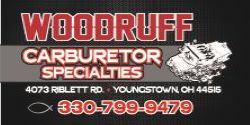I have a 1971 GTX with a Tremec TKO to a Dana 60 running 3.54 gearing. I am running a Holley 750 with 10.5 compression. Below is the build sheet and dyno sheets. The header are 1 and 7/8 pipes. A lot of machining was done, could not get the cam or heads that I wanted since it was just after covid. I would like some input on the size of the carb, should I keep the same or go larger or step up to fuel injection. The dyne run had the alternator and water pump installed.



Do I have the right carb size for my engine.
- Thread starter Gary Masse
- Start date
Also it had a edelbrock dual plane rpm performer intake
The cam specs as pre the picture below..Mechanical rollers, 1.6 rockers








PurpleBeeper
Well-Known Member
Your carburetor is about right. You could “try” a 850cfm, but I’m not sure it would make more horsepower
WileE
Well-Known Member
- Local time
- 12:02 AM
- Joined
- Sep 15, 2009
- Messages
- 20,690
- Reaction score
- 42,192
- Location
- State of insanity
Carb is fine.
PRHeads
Well-Known Member
- Local time
- 12:02 AM
- Joined
- Aug 31, 2018
- Messages
- 2,080
- Reaction score
- 3,114
- Location
- So. Burlington Vt
A 750 is a bit small on a 493, but there isn’t a magic 50hp from a carb swap either, especially if the current carb is one of the chokeless HP style pieces.
If the heads haven’t rec’d any porting, that’s where I’d go if I was looking for a more meaningful power gain.
Of course, that’s a way more involved proposition too.
Without some tweaking, the 75cc Ede heads have more valve shrouding and less low/mid-lift flow than the 84cc version.
If the current carb is a HP750 style, and you went to something like a QFT 950(1.450 venturi), both tuned for max power…… you might find 10-15hp.
The fact that the HP number is noticeably less than the TQ number is an indicator that the engine is air flow limited(can’t carry the TQ high enough in the curve to make a big HP number)…….. primarily heads and intake imo, and to some degree the carb too.
Of course it’s a snowball affect thing…….
Once the heads were ported, and a single plane intake installed…….. then the 1-7/8” headers would start to become a cork.
But…….. for what the basic combo is……. The numbers look about right.
Edit: after looking thru your invoice it appears there was 23.5hrs of porting on the heads?
If that’s the case, then I’d say the numbers are low(compared to what I’d expect to see here).
But, as I always say…….. it’s never wise to try and compare numbers from different dynos as “apples to apples”
Edit 2- I dug thru some sheets I had here……..
493 with prepped/blended std port Indy EZ heads, SD intake, similarly sized SR cam, 2-2 1/8 dyno headers, original Holley HP950.
HP and TQ within a few numbers of your sheet, with peaks occurring at about the same RPM.
If the heads haven’t rec’d any porting, that’s where I’d go if I was looking for a more meaningful power gain.
Of course, that’s a way more involved proposition too.
Without some tweaking, the 75cc Ede heads have more valve shrouding and less low/mid-lift flow than the 84cc version.
If the current carb is a HP750 style, and you went to something like a QFT 950(1.450 venturi), both tuned for max power…… you might find 10-15hp.
The fact that the HP number is noticeably less than the TQ number is an indicator that the engine is air flow limited(can’t carry the TQ high enough in the curve to make a big HP number)…….. primarily heads and intake imo, and to some degree the carb too.
Of course it’s a snowball affect thing…….
Once the heads were ported, and a single plane intake installed…….. then the 1-7/8” headers would start to become a cork.
But…….. for what the basic combo is……. The numbers look about right.
Edit: after looking thru your invoice it appears there was 23.5hrs of porting on the heads?
If that’s the case, then I’d say the numbers are low(compared to what I’d expect to see here).
But, as I always say…….. it’s never wise to try and compare numbers from different dynos as “apples to apples”
Edit 2- I dug thru some sheets I had here……..
493 with prepped/blended std port Indy EZ heads, SD intake, similarly sized SR cam, 2-2 1/8 dyno headers, original Holley HP950.
HP and TQ within a few numbers of your sheet, with peaks occurring at about the same RPM.
Last edited:
- Local time
- 11:02 PM
- Joined
- Aug 5, 2011
- Messages
- 3,920
- Reaction score
- 5,861
- Location
- Lisle, HELLinois!
What's with that Air/Fuel ratio???? Should be making more power than that? Oil P.S.I.???? Which numbers are good and which ones are not?
Stick with the carb, but with that cam & 1.6 rockers you may need an 850, but you need to get the A/F fixed.
Stick with the carb, but with that cam & 1.6 rockers you may need an 850, but you need to get the A/F fixed.
PRHeads
Well-Known Member
- Local time
- 12:02 AM
- Joined
- Aug 31, 2018
- Messages
- 2,080
- Reaction score
- 3,114
- Location
- So. Burlington Vt
Since the engine is using an appropriate amount of fuel for the power being produced……… I’m disregarding the A/F ratio numbers and feel they’re erroneous.but you need to get the A/F fixed.
I also don’t believe the negative 35lbs of oil pressure.
- Local time
- 9:02 PM
- Joined
- Apr 13, 2012
- Messages
- 40,638
- Reaction score
- 151,780
- Location
- Granite Bay CA
This comment had me curious as it relates to engine ratings that I have seen over the years.The fact that the HP number is noticeably less than the TQ number is an indicator that the engine is air flow limited(can’t carry the TQ high enough in the curve to make a big HP number)…….. primarily heads and intake imo, and to some degree the carb too.
For example...
The early 1970s GM 454-455 big blocks were high on torque but the 455s didn't have the same HP numbers as the Chevy. Chevrolet built a 454 SS truck in the early 90s that was a torque monster but made unimpressive HP. About that time a Ford Lightning with a smaller engine making less torque somehow made more horsepower and spanked the Chevy at the drag strip.
Airflow. That is what makes the difference between engines with torque and HP peaks closer together in numbers?
That is interesting.
I had my 440/493 ran on a chassis dyno in 2005 or 2006 and noticed a spread in the numbers. I was told that it was probably due to the MP '509 cam being an "ancient design". It was because of that that I tried my first Comp Cams stick, the XE285HL. IT seemed to run about the same on the street, I never drag raced it.
A lot of this stuff is mind boggling for me!
PRHeads
Well-Known Member
- Local time
- 12:02 AM
- Joined
- Aug 31, 2018
- Messages
- 2,080
- Reaction score
- 3,114
- Location
- So. Burlington Vt
I don’t even try and correlate engine dyno numbers/curves to those from a chassis dyno.
Fundamentally, on the engine dyno, making HP(that’s higher than the TQ) is mostly about carrying the tq curve up into(and past) the 5252rpm range.
The dyno is measuring TQ and calculating HP.
Since 5252 is the crossover point, the father past that you can get while still making decent TQ, the math starts working in your favor.
If you’re already way past peak by that point, and the curve is falling quickly, the HP will likely end up lower than the TQ.
Fundamentally, on the engine dyno, making HP(that’s higher than the TQ) is mostly about carrying the tq curve up into(and past) the 5252rpm range.
The dyno is measuring TQ and calculating HP.
Since 5252 is the crossover point, the father past that you can get while still making decent TQ, the math starts working in your favor.
If you’re already way past peak by that point, and the curve is falling quickly, the HP will likely end up lower than the TQ.
- Local time
- 9:02 PM
- Joined
- Apr 13, 2012
- Messages
- 40,638
- Reaction score
- 151,780
- Location
- Granite Bay CA
Since HP is just a mathematical conversion of torque and that HP and torque are equal at 5252 rpms, how does one measure HP at 5252 if an engine cannot rev that high to measure the torque there?
Apples and oranges, yeah but just curious about that. The powerful diesel engines that have peak torque WAY lower in rpms than peak HP come to mind. Does anyone actually spin a diesel much over 5000 rpms?
Apples and oranges, yeah but just curious about that. The powerful diesel engines that have peak torque WAY lower in rpms than peak HP come to mind. Does anyone actually spin a diesel much over 5000 rpms?
I'm curious about the A/F numbers too.
Yes there was a lot of porting of the heads and matching the intake manifold . I had asked about the oil pressure and It miss reads by 50 psi. Put a separate oil pressure gauge on it and it read 85 psi when the computer was at 35.
PRHeads
Well-Known Member
- Local time
- 12:02 AM
- Joined
- Aug 31, 2018
- Messages
- 2,080
- Reaction score
- 3,114
- Location
- So. Burlington Vt
Getting way off track here…… but, the math still works just fine for diesels and other low rpm stuff.
If you had a 400hp@2800 rpm diesel…… it’s making 750tq at that rpm.
One of my general hp/tq rules of thumb……..
Assuming a normal build that’s not experiencing “issues” while on the dyno…….. if the HP peak happens before 6000rpm, it’s likely to have less HP than TQ.
If you had a 400hp@2800 rpm diesel…… it’s making 750tq at that rpm.
One of my general hp/tq rules of thumb……..
Assuming a normal build that’s not experiencing “issues” while on the dyno…….. if the HP peak happens before 6000rpm, it’s likely to have less HP than TQ.
Last edited:
70bigblockdodge
Well-Known Member
5252 is just a constant to make the numbers work.
HP= T×rpm/5252
HP is a measurement of work. Force though a distance.
RPM is a velocity not a distance, so through angular velocities you can get a distance per second and then back to minutes. That number is the 5252. Basically converting rotation speed into a distance.
A semi truck diesel engine makes ~1800+ ft lbs at 13-1400 rpm and around 550 HP at 17-1800 rpm all done at 1900-2000 rpm. The torque number is way higher than the HP number because of the low RPM.
HP= T×rpm/5252
HP is a measurement of work. Force though a distance.
RPM is a velocity not a distance, so through angular velocities you can get a distance per second and then back to minutes. That number is the 5252. Basically converting rotation speed into a distance.
A semi truck diesel engine makes ~1800+ ft lbs at 13-1400 rpm and around 550 HP at 17-1800 rpm all done at 1900-2000 rpm. The torque number is way higher than the HP number because of the low RPM.
Orig69
Well-Known Member
- Local time
- 12:02 AM
- Joined
- May 16, 2021
- Messages
- 1,178
- Reaction score
- 7,104
- Location
- Toronto Ontario Canada
Chrysler decided to use an 850 CFM Thermoquad carb on brand new U code cars.
451Mopar
Well-Known Member
For the street the 750 is good because you usually are not driving at wide open throttle. If your racing a 950 would make a bit more power. This assumes that the air filter can handle it, or comparing both without an air filter.
I have a 3 by 16 inch filter. I tried a 14 by 3 inch and it was too thick
PRHeads
Well-Known Member
- Local time
- 12:02 AM
- Joined
- Aug 31, 2018
- Messages
- 2,080
- Reaction score
- 3,114
- Location
- So. Burlington Vt
One of my general hp/tq rules of thumb……..
Assuming a normal build that’s not experiencing “issues” while on the dyno…….. if the HP peak happens before 6000rpm, it’s likely to have less HP than TQ.
To clarify……. I’m referring to N/A combinations that are not running variable cam timing, variable length intake runners, or computerized engine management.
Similar threads
- Replies
- 70
- Views
- 8K
- Replies
- 10
- Views
- 1K
- Replies
- 18
- Views
- 1K
- Replies
- 2
- Views
- 2K
















